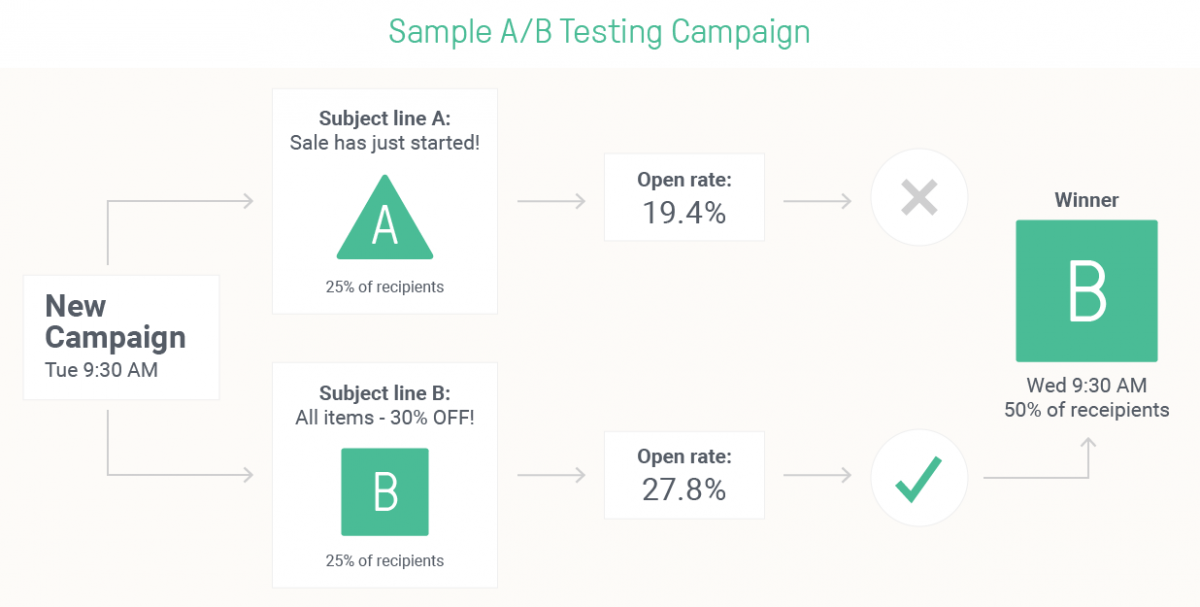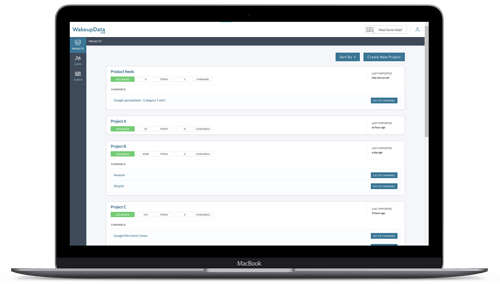A/B Split Testing for Ecommerce - Improve your Sales and Decrease CPC.
Posted on August 7, 2018 (Last Updated: January 24, 2024)
In this product update we are very pleased to announce the possibility of split-testing (A/B testing) for all WakeupData users.
First things first, what is split-testing?
Split testing (also called A/B testing) is a way of conducting controlled experiments with a test and control group of product data - and the only way of establishing the value to certain changes in your feed.
The goal is to improve your online sales or decrease your cost pr click by measuring and comparing a preset metric like clicks, impressions or purchases between the test and the control group to see if there is a significant difference between varying the two.
Proven results: There are countless examples of success stories from companies who used split testing in e-commerce to get fantastic results, including one which made $300 000 from split-testing with a few simple changes to their site wording.
A/B Testing in Email: Because Data is Power
A/B testing in email is much like in ads or UX: you’re looking to perform an experiment with different aspects of your emails to find what works the best.
Start from your KPIs: which aspect of your email campaigns do you want to improve?
Open rates:
To improve open rates, you should A/B test your email subject lines. There are several different things you can test:
- Test using a [First Name] tag or not
- Try out promotions using a physical currency sign (like $ or €) versus a %
- Test the same subject line with and without emojis
- Try different subject lines altogether
- Send emails from a business account or a personal account, for example: newsletter@ecommerceshop.com vs firstname@ecommerceshop.com
Click-Through Rate:
To test your click-through rate, you’ll need to look to your content. There are even more things to A/B test for the content of your campaigns:
- Test multiple images - it’s possible that your customers will respond better to certain images
- Test hero product - if you have an image in particular that is your header, like your hero product, test different hero products. Perhaps certain segments might react better to different promotional products.
- Test CTAs - if click-through rates have got you down, always test your CTA button size, color, text, etc. As a general rule, try to have only one CTA per email.
Order Rate:
Maybe your open and click-through rates are great, but you’re just not getting the orders you want from your campaigns. This is going to require a bit more thought in your A/B testing.
- Test the timing of your campaigns: emails sent at 8 a.m. have the best open, click-through, and order rates on average. Test timing to see which works best for your customers.
- Test your landing pages- see how your customers respond to where they’re being sent.
- Test your promotions- try out two different promotions to see which one sticks the most.
 Of course, when A/B testing these different elements, it’s important to keep a few things in mind so you perform your tests correctly. Here are some key tips to be successful with your A/B tests:
Of course, when A/B testing these different elements, it’s important to keep a few things in mind so you perform your tests correctly. Here are some key tips to be successful with your A/B tests:
- Only test one thing at a time: I know. You want to test it all, and there’s so much to analyze. But you need to think of the rest of your email as your control. Otherwise, you won’t know what really worked for your next campaign.
- Focus on one KPI at a time: While it might be tempting to try to improve everything at once, focus on what’s most important for you at the time. If your emails aren’t getting opened, there’s no sense in focusing on order rate.
- Don’t just blindly follow statistics: Statistics are great, but they’re hardly gospel. What really matters is what works for your customers. If you’re A/B testing two email newsletter elements, and what performs better is an unpopular choice, run with it. Your customers will help you decide what’s best.
These different elements for A/B testing can be applied to nearly every aspect of your ecommerce site and marketing strategy: UX, popup success, social media ads, etc.
No matter what, remember to test often and to record your results. Customer trends change over time, and you don’t want to be stuck using subject lines and copy that is passé.
What does WakeupData's split test service offer?
The main use of split testing in the past has been to optimize website and email marketing performance. But with this update, we are now moving it out to the channels that are responsible for driving traffic to your site.
"WakeupData is one of the only data feed management tools with the full set of solutions in place to allow users to carry out feed split-testing for ecommerce by themselves."
What does split-testing mean for WakeupData users?
The split test functions gives you huge possibilities in testing the performance of your product feeds on different sales channels like Google Shopping, Pricerunner, Prisjakt or 3rd party tools- even small improvements can make a big difference for bottom line and ROI.
A test means that the feed is effectively split (hence the name!), meaning some products will contain a new version of, for example, products titles, while the control group will contain the old version of product titles - without external factors like sales, low season, bad weather or broken checkout flow negatively impacting your results.
 The test results will then allow the user to easily see if certain included or excluding factors were significant, then take further action to implement this success across their entire feed.
The test results will then allow the user to easily see if certain included or excluding factors were significant, then take further action to implement this success across their entire feed.
Demonstrating your ROI can be easily assessed because all your split tests can be created with quantifiable goals in mind.
These goals might be, for example, to improve click rates or impressions, as they were with Swiss publisher Blick.
By trialing different titles and images on several separate split tests they were able to produce a significant increase in page impressions (4.9% per visitor) and click through rate (19.7%) which resulted in a major lift in their ad revenue.
This was of course with conventional split test for webpages. With the ability of doing split testing in feeds, you can now test new questions like:
- Does it really matter if the product brand is in a title, if the items aren't a priority brand?
- Does it really make a difference to clean up descriptions, or add keywords to them?
- Will adding colors to a product title have an impact on impressions?
How does split testing work on the WakeupData platform?
We want to answer this question thoroughly and effectively. Therefore, instead of outlining the process in this blogpost, we have produced a step-by-step pdf material pack on split testing which will outline in detail, how you can carry out the process on our platform - you can access it here or via our data feed management platform.
Find out more about Product Feeds or our Feed Marketing Platform and sign up for your Free Product Demo to get an insight today.





